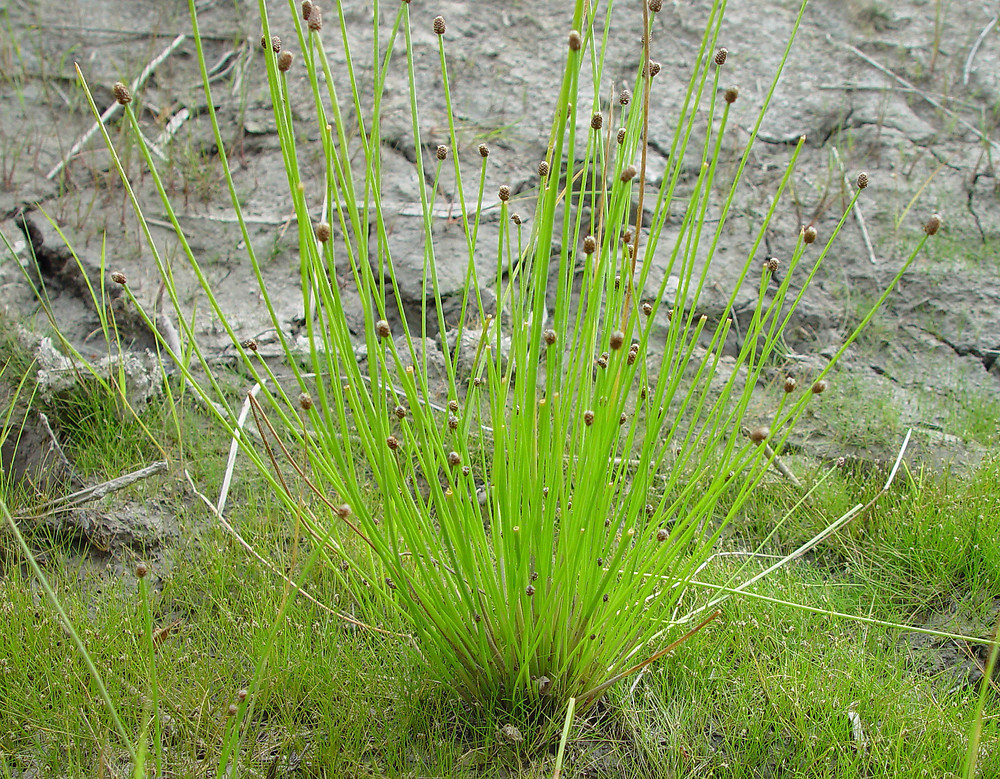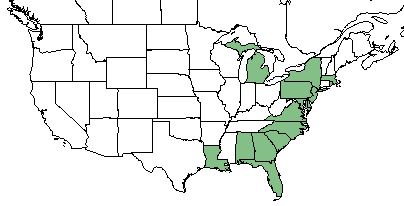Difference between revisions of "Eleocharis tricostata"
(→Ecology) |
(→Conservation and Management) |
||
| Line 43: | Line 43: | ||
==Conservation and Management== | ==Conservation and Management== | ||
| + | This species is listed as endangered by the Massachusetts Division of Fisheries and Wildlife, Natural Heritage and Endangered Species Program, by the New York Department of Environmental Conservation, Division of Land and Forests, and by the Rhode Island Department of Environmental Management. It is also listed as endangered and extirpated by the Maryland Department of Natural Resources, Natural Heritage Program, as threatened by the Michigan Department of Natural Resources, Natural Features Inventory, and as extirpated by the Pennsylvania Department of Conservation and Natural Resources.<ref name= "USDA"/> | ||
==Cultivation and restoration== | ==Cultivation and restoration== | ||
Revision as of 14:38, 3 May 2019
| Eleocharis tricostata | |
|---|---|

| |
| Photo by © Arthur Haines, New England Wild Flower Society | |
| Scientific classification | |
| Kingdom: | Plantae |
| Division: | Magnoliophyta - Flowering plants |
| Class: | Liliopsida - Moncots |
| Order: | Poales |
| Family: | Cyperaceae |
| Genus: | Eleocharis |
| Species: | E. tricostata |
| Binomial name | |
| Eleocharis tricostata Torr. | |

| |
| Natural range of Eleocharis tricostata from USDA NRCS Plants Database. | |
Common names: three-angle spikerush[1][2]
Contents
Taxonomic Notes
Synonyms: Scirpus tricostatus (Torrey) Kuntze, Trichophyllum ticostatum (Torrey) House[3]
Description
Eleocharis tricostata is a perennial, monoecious, graminoid sedge.[2]
Distribution
This sedge ranges from Massachusetts to Florida with sporadic occurrences inland in Michigan[4] and Louisiana.[2]
Ecology
Habitat
E. tricostata is an obligate wetland species[2] found in wet pine savannas, bogs,[1] cypress gum swamps, marshes, swales, flatwoods,[5] wet soil of pond margins, and infrequently in saline marshes.[4] Occurrences in such areas show the plants preference for sandy, peaty, and mucky soils.[5]
Phenology
It flowers and fruits between July and September.[1]
Conservation and Management
This species is listed as endangered by the Massachusetts Division of Fisheries and Wildlife, Natural Heritage and Endangered Species Program, by the New York Department of Environmental Conservation, Division of Land and Forests, and by the Rhode Island Department of Environmental Management. It is also listed as endangered and extirpated by the Maryland Department of Natural Resources, Natural Heritage Program, as threatened by the Michigan Department of Natural Resources, Natural Features Inventory, and as extirpated by the Pennsylvania Department of Conservation and Natural Resources.[2]
Cultivation and restoration
Photo Gallery
References and notes
- ↑ 1.0 1.1 1.2 Weakley A. S.(2015). Flora of the Southern and Mid-Atlantic States. Chapel Hill, NC: University of North Carolina Herbarium.
- ↑ 2.0 2.1 2.2 2.3 2.4 USDA, NRCS. (2016). The PLANTS Database (http://plants.usda.gov, 5 December 2017). National Plant Data Team, Greensboro, NC 27401-4901 USA.
- ↑ Wunderlin R. P., Hansen B. F., Franck A. R. and Essig. F. B. (2017). Atlas of Florida Plants (http://florida.plantatlas.usf.edu/).[S. M. Landry and K. N. Campbell (application development), USF Water Institute.] Institute for Systematic Botany, University of South Florida, Tampa.
- ↑ 4.0 4.1 Ward D. B. and Leigh E. M. (1975). Contributions to the Flora of Florida: 8, Eleocharis (Cyperaceae). Castanea 40(1):16-36.
- ↑ 5.0 5.1 NatureServe. (2017). NatureServe Explorer: An online encyclopedia of life [web application]. Version 7.1. NatureServe, Arlington, Virginia. Available http://explorer.natureserve.org. (Accessed: December 6, 2017 ).